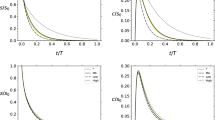Abstract
The dynamic form of the Michaelis–Menten enzymatic reaction equations provide a time-dependent model in which a substrate \(S\) reacts with an enzyme \(E\) to form a complex \(C\) which in turn is converted into a product \(P\) and the enzyme \(E\). In the present paper, we show that this system of four nonlinear equations can be reduced to a single nonlinear differential equation, which is simpler to solve numerically than the system of four equations. Applying the Lyapunov stability theory, we prove that the non-zero equilibrium for this equation is globally asymptotically stable, and hence that the non-zero steady-state solution for the full Michaelis–Menten enzymatic reaction model is globally asymptotically stable for all values of the model parameters. As such, the steady-state solutions considered in the literature are stable. We finally discuss properties of the numerical solutions to the dynamic Michaelis–Menten enzymatic reaction model, and show that at small and large time scales the solutions may be approximated analytically.



Similar content being viewed by others
References
L. Michaelis, M.L. Menten, Die kinetik der invertinwirkung. Biochem. Z. 49, 333–369 (1913)
C.L. Frenzen, P.K. Maini, Enzyme kinetics for two-step enzymic reaction with comparable initial enzyme-substrate ratios. J. Math. Biol. 26, 689–703 (1988)
S. Schnell, C. Mendoza, Closed form solution for time-dependent enzyme kinetics. J. Theor. Biol. 187, 207–212 (1997)
A.R. Tzafriri, Michaelis–Menten kinetics at high enzyme concentrations. Bull. Math. Biol. 65, 1111–1129 (2003)
A.R. Tzafriri, E.R. Edelman, The total quasi-steady state approximation is valid for reversible enzyme kinetics. J. Theor. Biol. 226, 303–313 (2004)
M. Golicnik, Explicit reformulations of time-dependent solution for a Michaelis–Menten enzyme reaction model. Anal. Biochem. 406, 94–96 (2010)
M. Golicnik, Explicit analytic approximations for time-dependent solutions of the generalized integrated Michaelis–Menten equation. Anal. Biochem. 411, 303–305 (2011)
I.M. Abu-Reesh, Optimal design of continuously stirred membrane reactors in series using Michaelis–Menten kinetics with competitive product inhibition: theoretical analysis. Desalination 180, 119–132 (2005)
M. Uma Maheswari, L. Rajendran, Analytical solution of non-linear enzyme reaction equations arising in mathematical chemistry. J. Math. Chem. 49, 1713–1726 (2011)
D. Vogt, On approximate analytical solutions of differential equations in enzyme kinetics using homotopy perturbation method. J. Math. Chem. 51, 826–842 (2013)
S. Liang, D.J. Jeffrey, Comparison of homotopy analysis method and homotopy perturbation method through an evolution equation. Commun. Nonlinear Sci. Numer. Simul. 14, 4057–4064 (2009)
M. Turkyilmazoglu, Some issues on HPM and HAM methods: a convergence scheme. Math. Comput. Model. 53, 1929–1936 (2011)
S.S. Motsa, S. Shateyi, Y. Khan, A new piecewise spectral homotopy analysis of the Michaelis–Menten enzymatic reactions model. Nume. Algorithms (in press) (2013)
A.L. Lehninger, D.L. Nelson, M.M. Cox, Lehninger Principles of Biochemistry (W.H. Freeman, New York, 2005)
J.P. LaSalle, S. Lefschetz, Stability by Lyapunov’s Second Method with Applications. Academic, New York (1961)
H. Degn, L.F. Olsen, J.W. Perram, Bistability, oscillation, and chaos in an enzyme reaction. Ann. N.Y. Acad. Sci. 316, 623–637 (1979)
E. Fehlberg, Low-Order Classical Runge–Kutta Formulas with Step Size Control and Their Application to Some Heat Transfer Problems. NASA Technical Report 315 (1969)
Acknowledgments
R.A.V. supported in part by NSF Grant # 1144246.
Author information
Authors and Affiliations
Corresponding author
Rights and permissions
About this article
Cite this article
Mallory, K., Van Gorder, R.A. A transformed time-dependent Michaelis–Menten enzymatic reaction model and its asymptotic stability. J Math Chem 52, 222–230 (2014). https://doi.org/10.1007/s10910-013-0257-1
Received:
Accepted:
Published:
Issue Date:
DOI: https://doi.org/10.1007/s10910-013-0257-1




